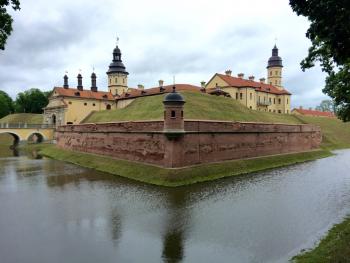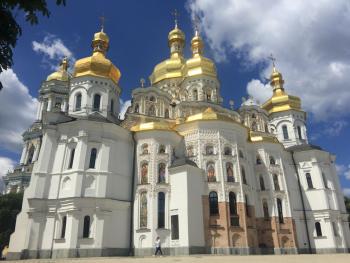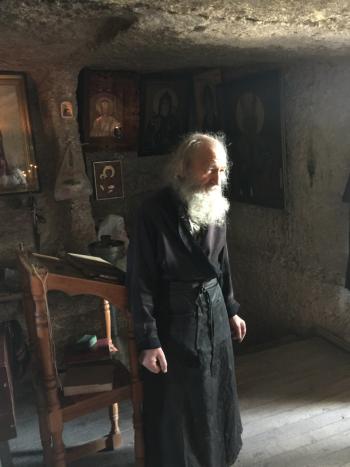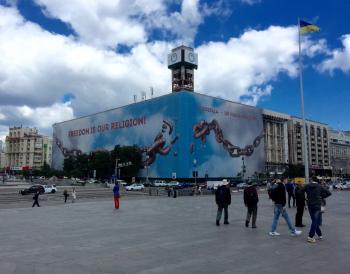Belarus, Ukraine and Moldova: Out from behind the Iron Curtain
This article appears on page 20 of the September 2017 issue.
In 2016, I booked a cruise through the Black Sea, but it was canceled because of turmoil in Ukraine and Turkey. That cruise was particularly attractive to my wife, Susan, and me, as it would have gotten us closer to achieving ITN’s All of Europe Travel Award, so I decided to look on the Internet for a land-based tour that would visit some of the Eastern European countries that were on the cruise itinerary. That search led me to a small English company that helped me turn lemons into lemonade (spiked with vodka).
Native Eye Travel (Olfrea House, White Horse Road, East Bergholt, Suffolk, England, CO7 6TU, U.K.; phone +44 [0] 20 3286 5995, www.nativeeyetravel.com) was offering a 16-day trip to Belarus, Ukraine and Moldova in June 2017, which we booked for £2,299 (then, $2,950) per person. We also asked for an upgrade to first class on two overnight train trips, which brought our total cost for two to $6,092.
Beginning in Belarus
After arriving in Minsk, Belarus, we met the four other travelers who had also chosen to take this tour. The group checked in at Hotel Belarus, a very comfortable, typical European 4-star hotel. I guess Susan and I were expecting a little less, based on the economical tour price and the warnings we’d heard that these countries had not yet developed a good tourism infrastructure, so we were pleasantly surprised.
Our lasting impression of Minsk is of a Soviet-style city dominated by sports stadiums, military museums and monuments. Much of Minsk was destroyed during World War II, so we saw very few historic buildings.
Two monuments that made an impression were the Island of Tears, a monument to fallen Belarusian soldiers in the Soviet war against Afghanistan, and the statue of Lenin that the locals call “Man on a Scooter” because of the way he is standing.
From Minsk, we continued to Polotsk. Our accommodations at Hotel Dvina were not as nice as those at our previous hotel, but still they were adequate.
Polotsk was full of history, dating back 1,200 years, but like that of all of the places we visited during this trip, most of it was turbulent. The most memorable site visited was the 12th-century Convent of St. Euphrosyne, with relics from the first Belarusian woman canonized (both by the Catholic and Eastern Orthodox churches).
Our next stop was Dzisna, a rural community, where we stayed overnight at a local family’s home, with four bedrooms and only one toilet. The family was wonderful, and the local women happily shared their folklore through dress, song, music and games.
We were given three huge meals using fresh vegetables from the family’s garden, and this was where we tasted our first bowl of borscht, which we washed down with shots of homemade vodka.
Returning to Minsk
On our way back to Minsk, we stopped at Khatyn, one of the most moving memorials we have ever visited. During World War II, the inhabitants of Khatyn were herded into a barn and the building was set on fire. One-hundred-forty-nine people, including 75 children, were burned alive or were shot trying to escape the burning building. Only three people survived.
The memorial, however, is not just for this one village but also for the residents of the more than 600 other villages that suffered a similar fate and for those Belarusians who were sent to concentration camps. Twenty-five percent of the population of Belarus — 2.3 million people — perished in WWII.
We spent the night in Minsk, and the next day we visited two 16th-century UNESCO Sites: the Fortress of Mir and the Palace of Njasvizh (Nesvizh).
Of the two, I much preferred the visit to the Palace of Njasvizh. The park, the palace’s restoration and the details about the former residents were wonderful.
On the other hand, Mir Fortress seemed more like a museum created out of the bones of the fortress rather than a representation of the original structure.
Our group then boarded an all-night train from Minsk to Kiev, Ukraine. Our upgrade to first class was definitely worth the extra money. Susan and I had a private cabin with two lower bunks, whereas our four travel mates shared a second-class cabin with two upper and two lower berths. They told us that they had difficulty finding places to put their luggage, and they had to deal with snoring issues.
Ukraine
In Kiev, we stayed at another 4-star hotel, Hotel Ukraine, situated on a hill overlooking Independence Square (bordered by the still-burned-out Trade Unions Building, which was set on fire during February 2014 protests). We saw many churches, monuments and government buildings during our city tour, but the three highlights were two UNESCO-listed religious sites, Saint-Sophia Cathedral and the Cave Monastery complex, and the city’s WWII memorial.
Most interesting were the monastery caves, which contained a complex system of narrow underground corridors consisting of burial naves and underground chapels originally established by a monk, Anthony of Kiev, in the 11th century. Unfortunately, no photography was allowed in the narrow caves.
Another overnight train took us to Lviv, where we checked into the Reikartz Medievale, which provided comfortable accommodations. Many of Lviv’s buildings were spared significant damage during WWII, and its historic center was designated as a UNESCO World Heritage Site. We loved walking through the central city, viewing the many historic churches, buildings and palaces.
At night, the city was alive with pedestrians, street musicians and people enjoying the many great restaurants, wine bars and coffeehouses. One notable restaurant was named The Most Expensive Galician Restaurant (14 Rynok Square, Apt. 8, second floor). There, we walked up a back staircase and were greeted by an elderly man in his tiny apartment. He ushered us through what we thought was his bedroom door, only to have it open to a huge Masonic speakeasy restaurant.
Visitors need to make sure to get a Lviv Card from the store on the first floor to get a 90% discount; otherwise, this is the most expensive restaurant in the country.
While in Lviv, we spent a day outside of town visiting castles and palaces in Olesko, Zolochiv and Pidgirtsi (Pidhirtsi). All were somewhat interesting and in various states of repair. Our guide explained that, with the war in the eastern part of Ukraine, it will be many years before funds will be available for restoration.
Into the mountains
We then drove to the Carpathian Mountains and stayed at a well-equipped village guest house. The rooms were equivalent to a 4-star hotel’s. Our hostess made dinner with, of course, borscht and other local dishes, including salad, pork fat on bread, pork chops and chicken plus more homemade vodka and fruit wine.
While in the mountains, we viewed what was billed as a waterfall, but we felt it was more like fast rapids in the middle of hundreds of souvenir stalls. We also took an interesting 4-kilometer hike up and down a hill, passing through gorgeous woods, looking down upon a stream and ending at a pile of boulders at the summit.
Our final stop in Ukraine was Chernivtsi, a beautiful walkable city with numerous churches and cathedrals. Highlights included another UNESCO Site, the Residence of Bukovinian & Dalmatian Metropolitans (now Chernivtsi National University), and St. Nicholas Cathedral.
While in Chernivtsi, we stayed at the Georg Palace. I’m going to say this was comparable to a 3-star hotel only because there was no elevator and all rooms were on the second floor. Otherwise, the rooms were great.
Moving on to Moldova
One full day of our tour was allocated to the drive from Chernivtsi to Chis¸inaˇu, Moldova. While it is not a particularly long drive, it is impossible to tell how long the border crossing might take, so ample time was allowed for the trip.
In Chis¸inaˇu, we stayed at another 4-star hotel, the Jolly Alon Hotel. Again, our room was comfortable, but the air-conditioner was probably from the Soviet era.
We stayed four nights and three days in Chis¸inaˇu. On the first day, we took a city tour and, of course, saw more churches, cathedrals and Soviet-style government buildings and lots of parks.
I admit I rolled my eyes when we were told we were going to the National Museum of Ethnography & Natural History, but I was very impressed. (Make sure you go downstairs to see the full skeleton of an ancient, elephant-like mammal found in Moldova.)
In the afternoon, we drove a bit outside of town to visit the Cricova winery. The wine cellars, located in tunnels 80 to 100 meters underground, stretch for 120 kilometers. After buzzing around the tunnels in a cart, we visited several tasting rooms.
For our group of six, the winery put out an ample 3-course lunch to accompany our seven tastings of their wine. Unfortunately, the wines that were our favorites are not imported to the US.
The next day we visited the Curchi Monastery. The setting was beautiful, and the complex included several recently completed cathedrals. We also visited the Orhei Vechi Monastery & Archaeological Complex, which has caves carved into a cliff, dating from the 13th century. There we walked down an incline into one of the caves (a “new” entrance from the 18th century) and met a monk who lived in the cave and presided over the chapel there.
Our last full day in Moldova found us traveling to the breakaway state of Transdniester (Transnistria), which is not recognized as an independent entity by any country. Although technically part of Moldova, we had to go through a border check, convert our money into Transnistrian rubles and be very careful of what we photographed, as the Russian army had many soldiers stationed there. One highlight of the visit was a remarkably well-preserved Turkish fortress dating from the 16th century.
Reflections
While I am not going to be so bold as to suggest that you should include these three former Soviet countries on your bucket list, for the well-traveled, these countries are special places with many unique sites, interesting cultural traditions and warm, welcoming people.
I would recommend that, prior to visiting, travelers should research the history of the region, including the Napoleonic Wars, the Ottoman period, WWII and the Swedish occupation. (Do as I say, not as I did!) Many Americans, including Susan and me, seem to focus far too much on where our troops fought rather than on the atrocities suffered by Eastern Europeans during WWII or on what life was like after the Russian Revolution, so reading a little about the history before you go will enhance your visit to this area. F




